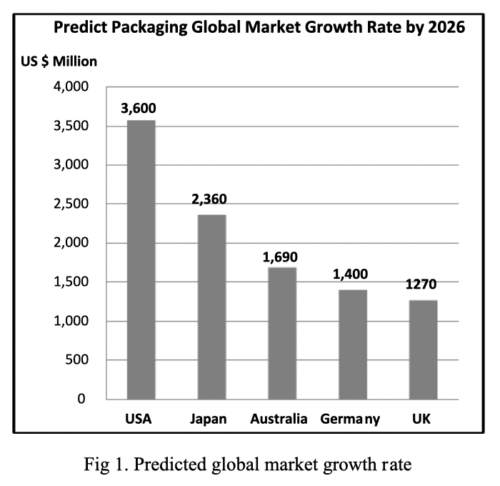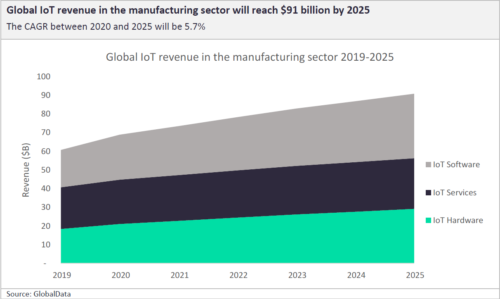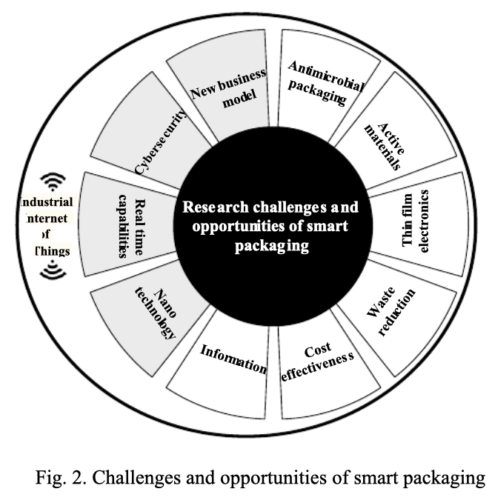26 September 2022

The importance and relevance of the Internet of Packaging or Smart/Intelligent/Active Packaging is growing as industry expands and the world becomes more connected. There are so many ways to implement the new technology of the Internet of Things (also known as Industry 4.0 – the integration of business processes with the IOT) into the packaging process; from machine and shipping optimization, to product packaging tracking and consumer engagement. Expected to grow 10% year-on-year to reach $20 billion by 2021 and $59 billion by the end of 2025 this technology is set to revolutionize the sector.

Smart Packaging, Intelligent Packaging and Active Packaging are often interchanged as synonyms – but they aren’t, the following definitions were taken from the paper Smart Packaging: Opportunities and Challenges. Going forward each term for such packaging will be used as contextually appropriate to the topic of conversation through this article.
The benefits of the Internet of Packaging for businesses are as extensive as the Metaverse – and just as lucrative. On the sales side 64% of consumers are interested in packaging being connected, whilst Digimarc’s recent study confirmed that 78% of consumers want more information than currently appears on pack. Already there is a huge market for Active Packaging which:
The market goes from consumers who want products to last longer and be in better condition when they buy them; to businesses who lose some 40% of produce in between sourcing, production and the final sale.
Businesses want to extract more insights about their products from the production line, through shipping to retail and then what happens after that all-important sale where they lose sight of their product and its impact. For brand marketing this would be an amazing opportunity to enforce their message, their impact and the importance of their products – or it would deliver the opportunity to alter their message to fit what happens after the sale. As well as marketing and production optimisation, Smart Packaging would lower the chances of human error damaging or wrongly packaging products which leads to customer complaints and bad reviews for the company. AI machines can keep a track of their own levels of work, their maintenance needs and often are programmed to do Machine Learning – which means that as they do the job they have been assigned their programming grows allowing them to get more efficient, more receptive and more intelligent. The table below shows the growth in revenue which the manufacturing sector of the Internet of Things will reach by 2025.

As for sustainability, the Internet of Things could be the answer brands have been looking for since consumers and watchdogs amped up transparency demands on big businesses taking responsibility for their impact on the environment. The World Economic Forum has estimated that combining Internet of Things technology with 5G and AI could help cut carbon emissions by 15%. But it isn’t just within factories that this technology can be applied, some sourcing networks are starting to use the technology within the forests they get trees from for the paper and pulp sector – a Finnish company is going to use drones to do inventories of its forests and improve decision making by utilizing AI. The Internet of Things will allow packaging companies to automate processes which before have been costly and rife with natural human error, as well as correct and fast analysis of gathered data.
There are of course risks with implementing technologies into your business that are relatively new in the industry. But the rewards would put you ahead of competitors who hesitate on this new breakthrough. That doesn’t take away from the challenges of the Internet of Packaging, it merely, (as with all new implementations) makes it worth the risk.

For example, cybersecurity is a very real threat, and if companies begin tracking their packaging once it leaves the shelf there is a huge issue of consumer data protection potentially being breached. However, as these issues become apparent there will be steps taken which will improve business security and in turn personal security. It is the ongoing argument of personal data which – if given up – will allow for better experiences for the individual that are customized to their wants, needs and ideal lifestyle; but it also means that machines will know more about the individual than they necessarily know about themselves. Similarly with businesses who trust their information to AI and big data caches there is the risk of machines knowing more about the business, packaging, products and clients than the people who run it (and incidentally these machines will do a better job of running the business than the humans who created them would). Dataism is the reliance on technology and algorithms, and therefore control of individuals via data tracking; but this is control not in the old sense of the phrase – control as in tracking, understanding and worryingly accurate predictions on what is best for us based on our genetic, psychological and physiological makeup. For the Internet Of Packaging this theory of Dataism is translated into knowledge of the product, the business and what is needed from the packaging to optimize both with complete trust in what the machine says from its human counterparts.
The future is looking more efficient, more sustainable and a lot more intelligent – but no machine can replicate the full range of emotions, the moral compass and genuine reactions that get humans to purchase a product based solely on the packaging.
Want help with your packaging to ensure it’s ready for the future? Get in touch with the BPAK team today to start your next packaging project.